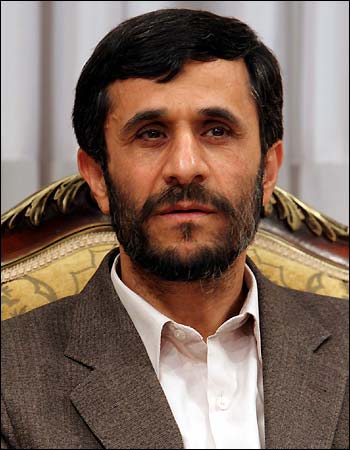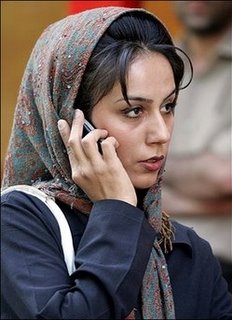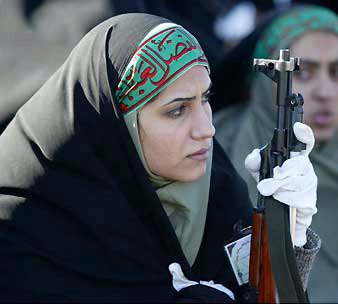|
|
|||||||||||||||||||||||||||||||
|
Iran: Nuclear Threat or Hype?
Nuclear Threat or Hype?The Islamic Republic of Iran was formerly known as Persia until 1935. The name Iran means "Land of the Aryans". Iran lies in an oil rich region bordering with Afghanistan, Armenia, Azerbaijan, Iraq, Pakistan, Turkey and Turkmenistan, is the world's sixth-largest oil exporter and about 60 per cent of the world's oil passes through the strategic Strait of Hormuz. The country is the 18th largest in the world (slightly larger than Alaska), has a population of 66 million and a military size of 900,000 active and reserve forces. Iran's military might is also bolstered by a volunteer militia called Basij which has 11 million members and is quite controversial because a decent percentage of its volunteer fighting force are women. Indeed Iran has a strange contradiction when it comes to women. Women are expected to wear the veil but many young Iranian women are more moderate (or Westernized) and observe veil wearing only to a limited extent in cities like Tehran. This varies wildly in the countryside however as Iran has 11 different ethnic groups living within its borders and a combination of Shia Muslims (89%), Sunni Muslims (9%) and minority religions. As one of the world's oldest surviving civilizations Iran has a rich cultural history and women warriors and leaders are not unheard of. Legendary female warrior Ku-baba took charge of the great city-state of Ur during the 24th century BC and numerous other examples of warrior women have flourished ever since.
Iran's climate is a combination of arid and subtropical and home to a plethora of wildlife with the most of the population settled in regions where there is ample food and water. This has contributed to one of the highest urban growth rates in the world. Between 1950 and 2002 the population shifted from 73% rural to 60% urban and it is estimated that approx. 80% of Iran's population will live in cities by 2020. Tehran is the largest of these cities, with a population near to 8 million and is the country's communication, transportation and economic hub. The second largest is Mashahd (2.8 million), a city considered holy by Shia Muslims because it is the site of the Imam Reza shrine. Between 15 and 20 million pilgrims and tourists go to the Imam Reza's shrine every year. In 1951 Iran's prime minister Dr. Mohammed Mossadegh nationalized Iran's oil reserves, which had previously been privately owned by a British corporation. Britain and the United States embargoed Iranian oil and eventually developed a plot to have Dr. Mohammed Mossadegh arrested. After Mossadegh's arrest Iran's leader Shah Reza Khan became an autocratic leader with the United States pulling his strings. With American help Reza Khan modernized Iran's government and infrastructure in a series of reforms known as the White Revolution, but he also crushed all forms of political opposition using his secret police, intimidation and gestapo tactics.
Religious leader Ayatollah Ruhollah Khomeini denounced the Shah's government as a corrupt dictatorship and was arrested in 1963 and imprisoned for 18 months. Khomeini was released in 1964 and after fleeing the country and returning in 1979 after the Islamic Revolution eventually forced the Shah to flee Iran in January 1979. In December 1979 Iran approved a theocratic constitution, whereby Ayatollah Ruhollah Khomeini became Supreme Leader of Iran. The revolution surprised the world's leaders and political pundits as it had not been precipitated by a military defeat, a financial crisis, or a peasant rebellion. Instead a combination of nationalists, Marxists, Islamic fundamentalists sought to overthrow the Shah and ultimately succeeded in creating an Islamic Republic under Ayatollah Ruhollah Khomeini. This time period was not without stressful situations. On November 4th 1979 a group of Iranian university students seized United States embassy and its personnel in Tehran for spying for the CIA and blamed the CIA for what had happened to Mohammad Mossadegh in 1953. Most of their hostages were released soon after, but the remaining fifty-two hostages were held for 444 days. Jimmy Carter's administration tried to negotiate and rescue hostages but was unsuccessful.
The Iran-Iraq WarAfter Ayatollah Ruhollah Khomeini took control of Iran, creating a conservative Shi'ite Islamic state the repercussions in Iraq were felt by Saddam Hussein, who believed in religious moderation and the separation of church and state. In 1980 Hussein claimed that Iranian forces was attempting to overthrow his government and declared war on Iran. The Iranian army was disbanded after the Iranian Revolution and was ill-equipped during the start of the war. Saddam Hussein's primary target was the region of Khuzestan which not only has a substantial Arab population, but boasted rich oil fields as well. By 1982 Iran managed to force Iraqi forces back across the Iraq border. It could have ended there but the United States provided Iraqi forces with chemical weapons and guns which they used to attack Iranian soldiers and civilians. Meanwhile the United States sold chemical weapons to Iran, playing both sides for fools. Iran was also sold chemical weapons from China, but nowhere in the amount that Iraq received from the United States. The war dragged on until 1988 with an estimated 1 million dead Iranians until Khomeini and Hussein accepted a truce brokered by the United Nations. In his own words Ayatollah Ruhollah Khomeini "drank the cup of poison" and accepted the truce with much reluctance. Ayatollah Ruhollah Khomeini died of a heart attack June 3rd 1989 at the age of 86. He was succeeded by Ali Khamenei.
The Post-War PeriodDuring the Gulf War Iran remained neutral in the fight against Iraq's invasion of Kuwait and instead focused on rebuilding Iran's shattered economy. Iranian President Akbar Hashemi Rafsanjani focused on promoting business partners and stayed in power until 1997 when he was replaced by reformist Mohammad Khatami who has a platform of "Islamic democracy". Despite protests and religious dissent Khatami was re-elected and served for eight years until 2005, but many of his reform efforts were blocked by religious bureaucracy within the Guardian Council and the conservative judiciary.
Post September 11thIn the post September 11th era Iranian politics was increasing polarizing Iran's political spectrum and conservative Mahmoud Ahmadinejad was elected in 2005. Often described as a religious fanatic and a puppet of Ayatollah Ali Khamenei, Ahmadinejad has the western world and Israel very worried.
Ahmadinejad has George W. Bush's "Axis of Evil" speech to thank for his election as many Iranians disliked being lumped together in the category of "Axis of Evil" and chose a candidate who was highly nationalistic and would defend Iran's honour international but instead has only raised alarm. Under Mahmoud Ahmadinejad's leadership Iran has launched an era of Uranium enrichment and nuclear weapons, calling for the destruction of Israel, and hosting events on whether the Jewish Holocaust during WWII was a myth. Ahmadinejad's has frequently denied that Iran is building nuclear weapons, but simultaneously emphasizes that Iran should have the right to protect itself using nuclear weapons. There is also a long list of human rights complaints against Mahmoud Ahmadinejad. Neighbouring countries Pakistan, India and Israel all have nuclear weapons and thus far have expressed little interest in using them except as retaliation in the event of a nuclear war. For all Mahmoud Ahmadinejad's sabre rattling and defiance however he is still Ayatollah Ali Khamenei's puppet. He is all hype, public relations and has comparatively little control over Iran's military and religious direction. The real power remains in the hands of the Ayatollah. There is however still some danger. Ali Khamenei is 69 years old and has not yet announced a successor. If he were to die and Mahmoud Ahmadinejad seized power the tension in the Middle East would reach a boiling point. The United States daily accuses of Iran of hiding a nuclear weapons program and tries to use trumped up threats of "Weapons of Mass Destruction" (very similar to the Bush Administrations WMD accusations in Iraq). Unlike Iraq however (which had used up all of its chemical weapons from the Iran-Iraq War) Iran has a strong nuclear power program and has been testing long range missiles, thus presenting a nuclear program capable of launching missiles as far as Israel.
For the United States and China the stakes are economically quite high. China needs Middle Eastern oil for its booming economy and the Americans are hoping to build an oil pipeline from Iraq, through Iran and Afghanistan to the Chinese border in eastern Afghanistan. The previous two wars in Iraq and Afghanistan pushed the US National debt over $9.3 trillion and Iran's population (66 million) and size is larger than both Afghanistan (32 million) and Iraq (28 million) combined. A war with Iran would likely cost the United States approx. $6 trillion in debt which will have to be paid off in higher taxes. It will fall to George W. Bush's successor to try and broker peace with Iran and finish the Iranian section of the oil pipeline. That or the United States (and likely Israel) may find itself in a war with a country that has a standing army of 12 million and potentially nuclear weapons. The Israeli factor in this equation cannot be ignored. Israel is not well liked by many countries in the region including Syria, Jordan and even the United States' allies Saudi Arabia and Pakistan have considerable numbers of people who dislike Israel. If Israel involved themselves in such a war it could potentially spill across multiply borders as Israel would likely be flying troops and armaments through Syrian air space. For average Americans who think such a war will never effect them except for a sharp rise in oil prices think again. The American military is so stretched out now they may need to draft both male and female civilians to fight in Iran. Perfectly normal men and women could find themselves being trained for a war they never asked for. So is Iran's nuclear ambitions all hype and bluster? We should all hope so. Fighting a street to street battle against Iran's 11 million strong Basij militia doesn't sound like a winning strategy. We can barely manage dealing with roadside bombs, suicide bombers and strong resistance in our two unfinished wars in Afghanistan and Iraq. A war with Iran might be biting off more than America can chew.
Extra StatisticsIran has 13.6 million cell phones in use (2006) and the average Iranian makes approx. $10,000/year. In 2007 Iran was home to 914,268 refugees from Afghanistan and 54,024 refugees from Iraq.
Human trafficking and slave trade is still practiced illegally in Iran where women and children are bought and sold as slave labour and for sexual exploitation. The Iranian government has made few attempts to stop the trafficking of women and children. Iran has 138.4 billion barrels of proven oil reserves and is the world's sixth largest oil exporter behind Saudi Arabia, the European Union, Russia, Norway and the United Arab Emirates. The minimum age for volunteering for the Basij Forces is 15 and both males and females are accepted. 1.4 million Iranian teenagers reach the age to join the Basij Forces every year. Life expectancy in Iran is 71 but the average age is 26. The US Treasury Department says it had so far blacklisted 34 entities and 11 individuals tied to Iranian nuclear proliferation activity. The Chinese company "China Great Wall Industry Corporation" (owned by the Chinese government) was removed from the blacklist in June 2008 for selling missile information and materials to Iran in 2006.
|
|
||||||||||||||||||||||||||||||
|
Website Design + SEO by designSEO.ca ~ Owned + Edited by Suzanne MacNevin | |||||||||||||||||||||||||||||||











